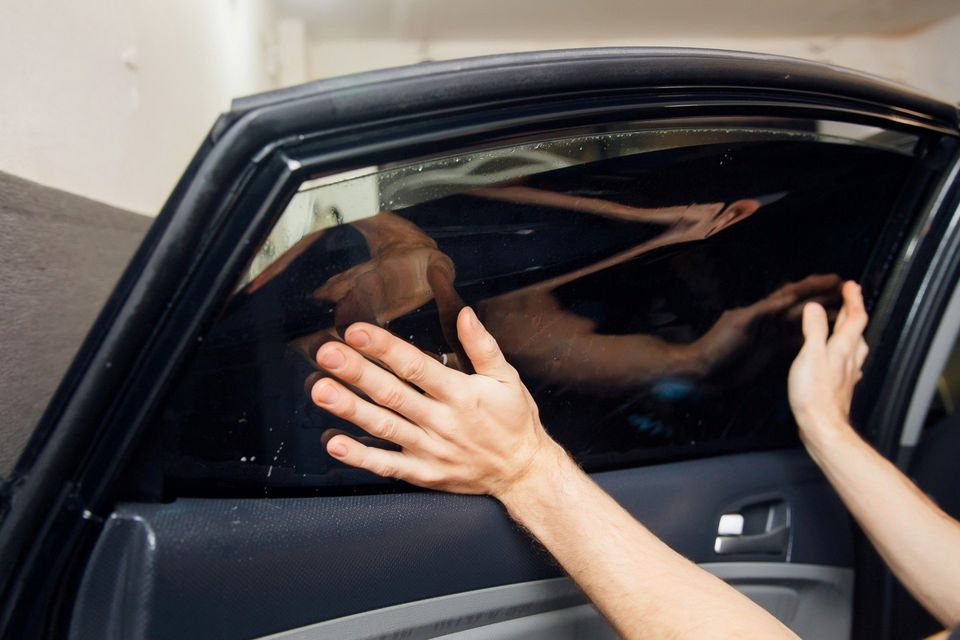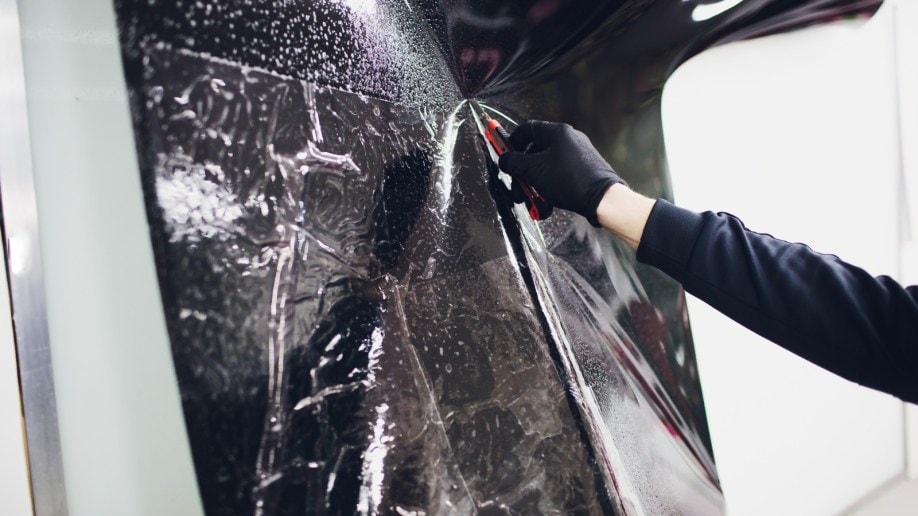A Comprehensive Overview to Understanding Car Window Tint and Its Advantages
Automobile home window tinting serves more than just an aesthetic objective for automobiles. It uses different types, each with distinctive features and advantages. Recognizing these alternatives, together with lawful laws and upkeep suggestions, is crucial for any lorry owner. The advantages might considerably enhance driving comfort and car durability. As one discovers the nuances of home window tinting, the inquiry emerges: what kind of color is finest matched for private requirements?
Comprehending Vehicle Home Window Tint: What It Is and How It Functions
Vehicle home window color acts as a protective obstacle that boosts automobile aesthetics while giving practical benefits. This thin movie is put on the indoor surface of car home windows, decreasing glare and obstructing dangerous ultraviolet (UV) rays from the sun. By filtering sunlight, automobile window color helps to manage the interior temperature of the lorry, bring about enhanced convenience for guests and reduced reliance on air conditioning.Additionally, it protects the automobile's inside from fading, preserving both furniture and control panel materials. The tint can additionally enhance privacy, making it harder for outsiders to see inside the automobile. Particular kinds of window tint can enhance security; in the event of an accident, the movie helps hold shattered glass together, minimizing the threat of injury from flying fragments. Overall, auto window tint offers both visual and sensible purposes, making it a popular selection among car proprietors.
Kinds Of Window Tint: An Introduction of Options
When considering window tint choices, several kinds are readily available, each with unique characteristics. Colored, metalized, and ceramic window tints supply varying levels of warmth denial, UV protection, and aesthetic charm. Comprehending these differences can help car owners make notified choices based on their choices and requirements.
Dyed Window Color
Dyed window color stands for a prominent selection amongst cars and truck proprietors seeking a efficient and budget friendly means to boost their automobile's aesthetics and personal privacy. This sort of color is produced by putting a layer of dye in between a protective coating and a sticky layer, causing a dark look that decreases glow and boosts visual convenience. While dyed window color effectively obstructs hazardous UV rays, it might not provide the exact same level of heat being rejected as various other color types. Furthermore, its color can fade over time, potentially decreasing its performance. In spite of these downsides, colored window color remains preferred for its cost-effectiveness and ability to supply a streamlined, trendy want to different lorry versions.
Metalized Home Window Tint
Metalized window color offers an equilibrium of design and performance, making it a prominent selection amongst cars and truck owners. This kind of tint incorporates metallic fragments within the movie, improving both aesthetic allure and warmth rejection. The reflective high quality of metalized tint aids to reduce glow and improve personal privacy, while also offering UV defense, which safeguards the automobile's inside. In addition, metalized home window tint can reinforce home window stamina, potentially avoiding ruining throughout accidents. It is important to note that the metal parts can interfere with digital signals, such as GPS and cell phone function. In general, metalized window color supplies an effective option for those seeking a combination of durability, appearance, and sunlight defense for their lorries.
Ceramic Home Window Color
Ceramic window color stands for an advanced alternative in the range of automobile window movies, providing unique benefits over traditional colors. Unlike dyed or metalized films, ceramic colors utilize innovative ceramic fragments, which efficiently turn down warmth and UV rays without jeopardizing exposure. This innovation guarantees that automobiles remain cooler, decreasing reliance on cooling and improving fuel effectiveness. Additionally, ceramic window tints are much less most likely to hinder digital devices, such as GPS or mobile signals, making them a useful option for modern lorries. In addition, their sturdiness and scrape resistance add to a much longer lifespan compared to other kinds of colors. On the whole, ceramic window tint offers exceptional efficiency, convenience, and protection, making it a preferred option for critical automobile owners.
Benefits of Auto Home Window Color: Beyond Appearances
While lots of people associate automobile home window tint with improved design, its advantages expand much beyond mere aesthetic appeals. One substantial advantage is warm decrease; window tint can block approximately 99% of unsafe UV rays, safeguarding and maintaining the indoor cooler furniture from fading. This not just enhances comfort throughout heat yet additionally decreases dependence on cooling, bring about improved gas efficiency.In addition, auto window color gives an included layer of personal privacy and protection. Colored home windows make it hard for outsiders to see inside the car, which can discourage theft and shield valuables. Additionally, lots of tints strengthen the glass, lowering the possibility of ruining in case of a mishap, thereby enhancing safety.In addition to these practical benefits, automobile home window tint can likewise add to glare reduction, boosting presence for motorists and travelers alike. This diverse technique to convenience and safety and security makes window tint a useful financial investment for automobile owners.
Legal Considerations: Tinting Laws by State
Prior to committing to car home window tint, lorry proprietors need to browse a complicated landscape of tinting guidelines that vary by state. Each state has particular laws controling the permissible levels of color darkness and reflectivity for different windows, consisting of windshields, front side home windows, and back home windows. These guidelines commonly consist of noticeable light transmission (VLT) link percents, which dictate just how much light can pass via the tinted glass.Some states allow darker colors on back home windows while restricting front side and windshield colors for safety factors. Furthermore, certain states might require a certification from the manufacturer to validate conformity with tinting legislations. Breaching these policies can lead to penalties, required removal of the color, or both. It is vital for lorry proprietors to research their state's laws extensively to assure legal conformity prior to mounting window tint. This diligence can save money and time in the lengthy run.
Choosing the Right Tint: Factors to Think about
When selecting the appropriate window tint for an automobile, several critical variables enter into play. Color darkness degrees, UV defense scores, and compliance with lawful regulations are crucial factors to consider to assure both aesthetic appeals and functionality. Assessing these aspects will certainly assist individuals make an educated decision that satisfies their requirements and abides by neighborhood regulations.
Tint Darkness Degrees
Selecting the proper tint darkness level is necessary for attaining the wanted equilibrium in between visual appeals and functionality in car home window tinting. Different states have varying legal guidelines concerning color darkness, which can affect the selection. Usually, tints are measured in portions, with lower percents showing darker shades. Darker colors provide raised personal privacy and a sleek look but can reduce exposure, especially during the night. On the other hand, lighter tints maintain an even more his explanation open feel, making certain appropriate presence while still supplying some warmth and glow reduction. Individuals should consider their driving habits, local legislations, and personal preferences when choosing. Inevitably, the appropriate color darkness level boosts the car's look while guaranteeing security and compliance with lawful requirements.
UV Security Score
Color darkness degrees play a significant function in the overall performance of automobile home window tinting, yet another vital aspect to assess is the UV protection score of the chosen tint. This ranking indicates the percentage of unsafe ultraviolet rays that the color can obstruct. Premium tints frequently offer 99% or more UV protection, securing guests and the car's inside from check this site out sunlight damages. Davinci of Michigan. Long term direct exposure to UV rays can bring about skin issues and fading of upholstery, making a high UV protection rating vital for health and longevity. When choosing window tint, customers ought to prioritize this score together with darkness degrees to guarantee optimum comfort and safety while driving. Comprehending these aspects aids in making a notified decision when purchasing vehicle home window tinting
Lawful Rules Compliance
Recognizing local legal regulations is vital for anybody considering vehicle window tinting. Each state or region has details legislations regulating the allowable levels of color darkness and reflectivity for various windows. These policies often specify the visible light transmission percent, identifying just how much light can travel through the tinted glass. Non-compliance can result in penalties, mandatory removal of the tint, or concerns throughout automobile evaluations. Additionally, some areas might have limitations on making use of particular tinting products, calling for customers to choose items that fulfill safety and security standards. It is essential for vehicle owners to investigate their neighborhood regulations completely before picking window tint to guarantee conformity and avoid potential legal complications.

Installation Process: DIY vs. Specialist Providers
How does one make a decision between a DIY installment and working with specialist solutions for car window tinting? The choice typically hinges on budget, experience, and preferred results. A DIY method can be economical, allowing people to minimize labor costs. It requires a particular degree of ability and expertise about the tinting procedure. Those who are thorough and person might discover success with DIY packages available in the market.Conversely, specialist services offer competence and high-grade materials, ensuring a flawless surface. Professionals often guarantee their job, giving satisfaction versus potential problems such as gurgling or peeling off. Furthermore, they know with neighborhood regulations regarding tinting, which can be complex for the ordinary car owner.Ultimately, the decision shows an equilibrium in between expense, personal capability, and the expected high quality of the tinting task. Each choice has its benefits, and the very best option depends on private situations and preferences.
Upkeep Tips: Keeping Your Color in Top Problem

Regularly Asked Inquiries
How Long Does Window Tint Usually Last on a Car?
Window tint normally lasts between 5 to ten years, depending upon variables such as high quality, application, and ecological problems. Routine upkeep and appropriate care can prolong its lifespan, making sure perfect performance and appearance over time.
Can Window Tinting Damages My Cars and truck's Original Glass?
Window tinting, when applied appropriately, does not harm a car's original glass. Improper setup or low-quality materials may lead to concerns like gurgling or peeling, potentially affecting the glass's honesty over time.
Is Home Window Tinting Safe for All Sorts Of Vehicles?
Home window tinting is normally risk-free for the majority of vehicles, supplied the movie follows neighborhood guidelines and is properly used. Some specialized vehicles might call for particular considerations, making it vital to seek advice from professionals before installation.
Will Home Window Tinting Void My Auto Warranty?
The concern of whether window tinting voids a car guarantee frequently depends on the maker's policies. Generally, if the color does not damage the lorry, service warranties typically stay undamaged. However, getting in touch with the dealership is a good idea.
Can I Get Rid Of Window Color Myself if Needed?
Eliminating home window tint oneself is feasible, however it needs cautious interest to avoid damaging the glass. People must utilize suitable devices and methods to guarantee a successful removal without leaving adhesive residue or scrapes behind. While dyed window tint successfully blocks dangerous UV rays, it might not use the same degree of warm being rejected as various other tint types. Ceramic home window color stands for an advanced alternative in the spectrum of vehicle window movies, using distinctive benefits over conventional tints. Before devoting to vehicle window tint, car proprietors must browse an intricate landscape of tinting policies that vary by state. These guidelines usually include noticeable light transmission (VLT) percentages, which dictate how much light can pass with the tinted glass.Some states permit darker tints on back windows while restricting front side and windshield tints for safety reasons. Tint darkness degrees play a significant duty in the overall effectiveness of automobile window tinting, but an additional crucial factor to review is the UV security ranking of the picked color.